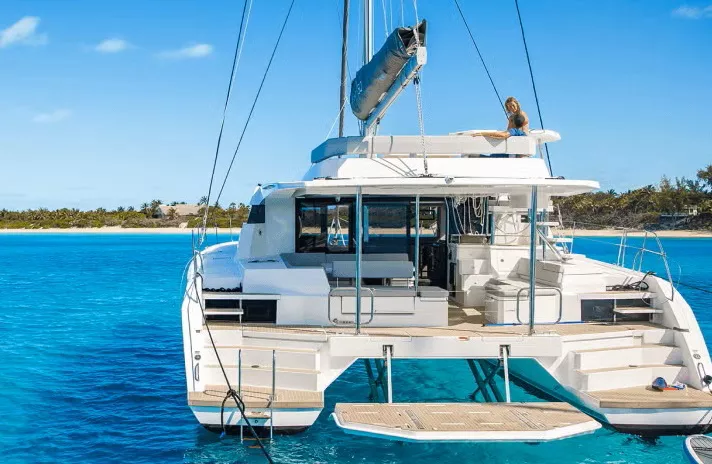Catamarans are distinctive watercraft featuring two parallel hulls of equal size. This design offers advantages over traditional monohull boats, including enhanced stability, speed, and efficiency. In this article, we will delve into the key characteristics of catamaran hulls, exploring their design, performance, and the benefits they offer to sailors and passengers alike.
What Is A Characteristic Of A Catamaran Hull?
Catamarans are watercraft with two parallel hulls of equal size. This design provides greater stability through resistance to rolling and overturning, eliminating the need for ballast. Catamarans typically have less hull volume, smaller displacement, and shallower draft than monohulls of comparable length. The two hulls combined often have smaller hydrodynamic resistance, requiring less propulsive power from sails or motors.
Design Features of Catamaran Hulls
Twin Hull Configuration
The most distinguishing feature of a catamaran is its twin hulls. This configuration provides several benefits:
- Enhanced Stability: The wide distance between the hulls imparts stability, reducing the risk of capsizing and minimizing heeling.
- Increased Deck Space: The space between the hulls allows for expansive deck areas, providing ample room for passengers and equipment.
Width and Stability
The wide beam of a catamaran contributes significantly to its stability:
- Reduced Roll: The broad stance minimizes rolling motions, offering a smoother ride in various sea conditions.
- Improved Load Distribution: The width allows for better distribution of weight, enhancing overall balance and stability.
Shallow Draft and Versatility
Catamarans typically have a shallow draft, which offers several advantages:
- Access to Shallow Waters: The reduced draft allows catamarans to navigate shallow waters, providing access to areas that may be inaccessible to deeper-drafted vessels.
- Beachability: Some catamarans can be beached easily due to their shallow draft, facilitating beach landings and departures.
Reduced Hydrodynamic Resistance
The design of catamaran hulls results in lower hydrodynamic resistance:
- Efficient Movement: The twin hulls create less drag, allowing the catamaran to move efficiently through the water with less energy.
- Fuel and Energy Savings: Reduced resistance leads to lower fuel consumption for motorized catamarans and improved performance for sailing catamarans.
Performance Advantages
Speed and Fuel Efficiency
Catamarans are known for their speed and efficiency:
- High-Speed Capabilities: Racing catamarans can achieve speeds of 30 to 40 knots, while cruising catamarans typically range from 9 to 15 knots, depending on their design and load.
- Improved Fuel Economy: The reduced hydrodynamic resistance allows for better fuel efficiency, making catamarans cost-effective for long-distance travel.
Seaworthiness and Handling
The structural design of catamarans enhances their seaworthiness:
- Stability in Rough Seas: The wide beam and twin hulls provide stability in rough seas, reducing the likelihood of capsizing.
- Handling Characteristics: Catamarans handle differently from monohulls, with reduced heeling and wave-induced motion, contributing to a more comfortable ride.
Comfort and Reduced Motion
Passengers often prefer catamarans for their comfort:
- Minimal Roll: The stable design minimizes rolling, reducing seasickness and enhancing passenger comfort.
- Smooth Ride: The reduced motion provides a more pleasant experience, especially during longer voyages.
Structural Considerations
Lightweight Construction
Catamarans are often constructed with lightweight materials:
- Enhanced Performance: Lightweight construction contributes to better speed and fuel efficiency.
- Increased Payload Capacity: Reducing the vessel’s weight allows for greater payload capacity without compromising performance.
Handling Characteristics
Windward Performance
Catamarans exhibit unique behaviors when sailing windward (toward the wind):
- Reduced Heeling: Due to their wide beam and twin hulls, catamarans experience minimal heeling, maintaining a more upright position compared to monohulls.
- Responsive Steering: With twin rudders and the absence of a deep keel, catamarans offer precise and immediate steering responses, enhancing control when navigating windward.
- Increased Sail Area: The ample deck space allows for larger sail plans, providing greater power and efficiency when sailing into the wind.
Maneuverability
Catamarans exhibit distinct handling characteristics:
- Flat Turning Profile: They tend to turn with a flatter attitude, leaning less into turns compared to monohulls, offering a different steering experience.
- Responsive Throttling: Adjusting engine power leads to immediate changes in speed and direction, making docking and close-quarters maneuvering more straightforward.
- Minimal Wake: The design reduces wake turbulence, beneficial in crowded or sensitive environments.
Conclusion
Catamaran hulls present a distinctive blend of stability, speed, and efficiency, making them a popular choice among sailors. Their twin-hull configuration offers enhanced stability, reduced heeling, and increased deck space, contributing to a comfortable sailing experience. Performance-wise, catamarans excel in speed and fuel efficiency, owing to their reduced hydrodynamic resistance. Structural innovations have led to lightweight yet durable constructions, ensuring longevity and reliability. Handling characteristics, including responsive steering and flat turning profiles, further enhance their appeal. Understanding these features is essential for sailors seeking vessels that combine performance with comfort and versatility.

